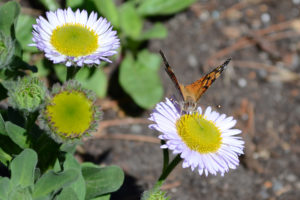In 1910, Francis X. Williams predicted in the journal Entomological News that San Francisco’s bugs and butterflies were “destined to become a thing of the past,” victims of recent development covering the city’s western sand dunes; the small market farms replacing the verdant valley of Laguna de la Merced; the frequent fires consuming Lone Mountain; and the exotic Monterey cypress and pine, acacia, and eucalyptus trees crowding out native vegetation. He could find only 30 butterfly species in 1910, he said, whereas 43 species once inhabited San Francisco. “Before a decade has passed away, there will be little left of the insect fauna of our city,” he concluded.
“All in all, his prediction of butterfly loss was incorrect,” says Matt Zlatunich, a butterfly enthusiast who’s also a San Francisco firefighter. What Williams hadn’t counted on in 1910, says Zlatunich, were private gardens and the lands eventually preserved and even restored in various parts of the Golden Gate National Recreation Area, the Presidio, and sections of city parks managed by the Natural Areas Program.
- Western pygmy blue butterfly, the smallest butterfly in the western United States. Photo by Paul Johnson.
As a kid, Zlatunich caught butterflies and pinned them to boards; as an adult, he wanted to reconnect to his passion in a different way. He joined fellow amateur lepidopterist Liam O’Brien on a three-year butterfly survey at the Presidio, where they counted 31 species. O’Brien, who has also surveyed a dozen other spots in the city, is up to 35 species citywide, including the gulf fritillary and the western pygmy blue (the smallest butterfly in the western United States).
His count isn’t too far from Williams’s historical number, though the species are different. Some species once considered common are now rare, and at least one, the Xerces blue, has gone extinct. O’Brien says generalist species that thrive in weedy lots are doing better than specialists that need specific host plants. “Anise swallowtails once flew only in the spring in San Francisco,” says O’Brien, “but with the introduction of exotic fennel, females now lay eggs virtually year-round.”
In addition to his ongoing surveys, O’Brien leads the annual San Francisco Butterfly Count in conjunction with the North American Butterfly Association. All butterfly enthusiasts can join this year’s count. Just show up at San Francisco’s Randall Museum on Monday, June 7, 2010, says O’Brien. He is especially excited to check for butterflies along the Green Hairstreak Corridor in the Sunset District, where he helps lead a project with the nonprofit Nature in the City and local volunteers to plant host and nectar sources (learn more from our article on the program). “To see a green hairstreak sitting on a coastal buckwheat during flight season would be like finding Willy Wonka’s golden ticket,” says O’Brien, who encourages novices to participate on the day of the count. “We do a hardcore day of counting,” he says, “but unlike at bird counts, we chat our heads off out there.” For information, go to natureinthecity.org.

.jpg)




